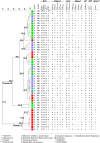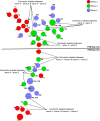A single-center analysis of clonal transmission of carbapenem-resistant Acinetobacter baumannii among intensive care unit patients during the COVID-19 pandemic
- PMID: 39468199
- PMCID: PMC11519864
- DOI: 10.1038/s41598-024-77238-4
A single-center analysis of clonal transmission of carbapenem-resistant Acinetobacter baumannii among intensive care unit patients during the COVID-19 pandemic
Abstract
Carbapenem-Resistant Acinetobacter baumannii (CRAB) outbreak in intensive care units (ICUs) is a significant problem for healthcare facilities. In this study, we aimed to investigate the occurrence of CRAB isolates among ICU-admitted patients during the three waves of the COVID-19 pandemic in Iran using Multiple-Locus Variable Number Tandem-Repeat Analysis (MLVA). We obtained 50 (A) baumannii isolates from tracheal aspirate and blood culture samples. In the disc diffusion method, all isolates were cefotaxime, ceftriaxone, and cefepime-resistant, while 98% (49/50) of isolates were resistant to piperacillin, piperacillin-tazobactam, ceftazidime, and ciprofloxacin. Levofloxacin and tobramycin resistance was found in 76% (38/50) of isolates. In the microbroth dilution test all isolates were resistant to imipenem, 98% (49/50) to meropenem, 68% (34/50) to colistin, and 20% (10/50) to polymyxin (B) Based on the PCR findings, all isolates harbored blaOXA-40, ISAba-1, and int-2 genes. There were no isolates found that have the blaOXA-58, blaOXA-143, blaVEB-1, blaVIM, and int-3 genes. Among Extended-spectrum beta-lactamases (ESBL) genes, blaCTX-M, blaTEM, blaSHV, blaGES, and blaPER-1 have a prevalence of 42% (21/50), 84% (42/50), 58% (29/50), 78% (39/50), and 54% (27/50), respectively. 74% (37/50) of the isolates had the blaOXA-23 gene, while all of the isolates carried the blaOXA-40 gene. Among MBL genes, blaIPM, blaGIM, blaSIM, and blaNDM-1 have a prevalence of 20% (10/50), 8% (4/50), 22% (11/50), and 60% (30/50), respectively. The prevalence of int-1 was documented as 74% (37/50). Accordingly, all isolates were identified as CRAB. The co-existence of blaOXA-23/int-2 and blaOXA-23/isaba-1 was 74% (37/50). The co-existence of blaNDM-1/ISAba-1 was observed in 30 (60%) isolates. Using an 80% similarity threshold on the dendrogram constructed through MLVA typing, all isolates were grouped into two clusters: cluster A with 9 isolates from wave 3, and cluster B with 41 isolates from waves 3, 4, and 5. Our study confirms a clonal transmission of CRAB during the study period and suggests using molecular typing methods like MLVA in healthcare settings to identify dominant clones, antibiotic resistance patterns, and transmission routes. This will help to better manage the emergence and spread of antibiotic-resistant strains in future outbreaks.
Keywords: COVID-19; Carbapenem-Resistant Acinetobacter baumannii; Dendrogram; ESBL; MBL; MLVA; Minimum spanning tree.
© 2024. The Author(s).
Conflict of interest statement
The authors declare no competing interests.
Figures




References
-
- Sheng, W.-H. et al. A multicenter study of risk factors and outcome of hospitalized patients with infections due to carbapenem-resistant Acinetobacter baumannii. Int. J. Infect. Dis.14, e764–e769. 10.1016/j.ijid.2010.02.2254 (2010). - PubMed
MeSH terms
Substances
LinkOut - more resources
Full Text Sources
Medical
Miscellaneous

